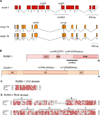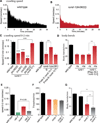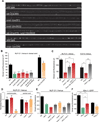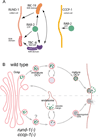Two Rab2 interactors regulate dense-core vesicle maturation
- PMID: 24698274
- PMCID: PMC3997996
- DOI: 10.1016/j.neuron.2014.02.017
Two Rab2 interactors regulate dense-core vesicle maturation
Abstract
Peptide neuromodulators are released from a unique organelle: the dense-core vesicle. Dense-core vesicles are generated at the trans-Golgi and then sort cargo during maturation before being secreted. To identify proteins that act in this pathway, we performed a genetic screen in Caenorhabditis elegans for mutants defective in dense-core vesicle function. We identified two conserved Rab2-binding proteins: RUND-1, a RUN domain protein, and CCCP-1, a coiled-coil protein. RUND-1 and CCCP-1 colocalize with RAB-2 at the Golgi, and rab-2, rund-1, and cccp-1 mutants have similar defects in sorting soluble and transmembrane dense-core vesicle cargos. RUND-1 also interacts with the Rab2 GAP protein TBC-8 and the BAR domain protein RIC-19, a RAB-2 effector. In summary, a pathway of conserved proteins controls the maturation of dense-core vesicles at the trans-Golgi network.
Copyright © 2014 Elsevier Inc. All rights reserved.
Figures







Similar articles
-
The EARP Complex and Its Interactor EIPR-1 Are Required for Cargo Sorting to Dense-Core Vesicles.PLoS Genet. 2016 May 18;12(5):e1006074. doi: 10.1371/journal.pgen.1006074. eCollection 2016 May. PLoS Genet. 2016. PMID: 27191843 Free PMC article.
-
TBC-8, a putative RAB-2 GAP, regulates dense core vesicle maturation in Caenorhabditis elegans.PLoS Genet. 2012;8(5):e1002722. doi: 10.1371/journal.pgen.1002722. Epub 2012 May 24. PLoS Genet. 2012. PMID: 22654674 Free PMC article.
-
UNC-108/RAB-2 and its effector RIC-19 are involved in dense core vesicle maturation in Caenorhabditis elegans.J Cell Biol. 2009 Sep 21;186(6):897-914. doi: 10.1083/jcb.200902096. J Cell Biol. 2009. PMID: 19797081 Free PMC article.
-
The dense-core vesicle maturation protein CCCP-1 binds RAB-2 and membranes through its C-terminal domain.Traffic. 2017 Nov;18(11):720-732. doi: 10.1111/tra.12507. Epub 2017 Sep 13. Traffic. 2017. PMID: 28755404 Free PMC article.
-
Plant Golgi ultrastructure.J Microsc. 2020 Nov;280(2):111-121. doi: 10.1111/jmi.12899. Epub 2020 May 27. J Microsc. 2020. PMID: 32420623 Review.
Cited by
-
RAB2A Polymorphism impacts prefrontal morphology, functional connectivity, and working memory.Hum Brain Mapp. 2015 Nov;36(11):4372-82. doi: 10.1002/hbm.22924. Epub 2015 Aug 7. Hum Brain Mapp. 2015. PMID: 26249043 Free PMC article.
-
Presynaptic Precursor Vesicles-Cargo, Biogenesis, and Kinesin-Based Transport across Species.Cells. 2023 Sep 11;12(18):2248. doi: 10.3390/cells12182248. Cells. 2023. PMID: 37759474 Free PMC article. Review.
-
Genetic dissection of neuropeptide cell biology at high and low activity in a defined sensory neuron.Proc Natl Acad Sci U S A. 2018 Jul 17;115(29):E6890-E6899. doi: 10.1073/pnas.1714610115. Epub 2018 Jun 29. Proc Natl Acad Sci U S A. 2018. PMID: 29959203 Free PMC article.
-
The EARP Complex and Its Interactor EIPR-1 Are Required for Cargo Sorting to Dense-Core Vesicles.PLoS Genet. 2016 May 18;12(5):e1006074. doi: 10.1371/journal.pgen.1006074. eCollection 2016 May. PLoS Genet. 2016. PMID: 27191843 Free PMC article.
-
New approaches for solving old problems in neuronal protein trafficking.Mol Cell Neurosci. 2018 Sep;91:48-66. doi: 10.1016/j.mcn.2018.04.004. Epub 2018 Apr 10. Mol Cell Neurosci. 2018. PMID: 29649542 Free PMC article. Review.
References
-
- Ann K, Kowalchyk JA, Loyet KM, Martin TF. Novel Ca2+-binding protein (CAPS) related to UNC-31 required for Ca2+-activated exocytosis. J. Biol. Chem. 1997;272:19637–19640. - PubMed
Publication types
MeSH terms
Substances
Associated data
- Actions
- Actions
Grants and funding
LinkOut - more resources
Full Text Sources
Other Literature Sources
Molecular Biology Databases
Research Materials
Miscellaneous

